A Splash Of Color In A Sea of White
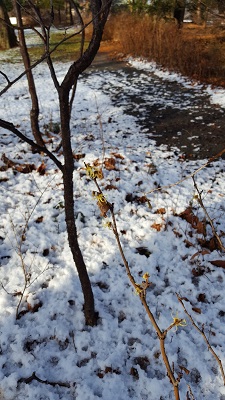
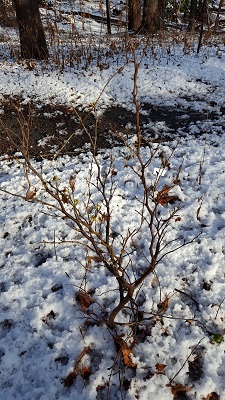
While walking on a wintery December day, you might stumble across a peculiar plant. One that appears to be all mixed up, blooming in winter as if nobody had told it what time of year it was. With its uniquely shaped yellow blossoms, this shrub is none other than Witch Hazel, Hamamelis virginiana.
With all of the typical characteristics of a flower pollinated by animals, scientists and admirers alike were perplexed for a long time over what pollinator would be active in wintertime. Enter naturalist Bernd Heinrich, who discovered that a particular group of insects in the Owlet Moth family are active on winter nights. By utilizing a shivering technique, these winter moths are able to warm their bodies up so that they can take flight and search for food. While mostly feeding on sap from injured trees, Heinrich found that these moths also visited Witch Hazel flowers. And thus the mystery was solved! (posted 12/12/19)
Northern Shoveler at Freneau Woods

Recently, a small flock of Northern Shovelers were spotted in Lake Lefferts near Freneau Woods Park, Aberdeen. These dabbling ducks love marshy or muddy ponds and shallow lakes to feed on aquatic plants and animals. They use their large bill, about 2.5 inches long and shaped like a shovel, as a strainer. This odd shaped bill has about 110 tiny projections, called lamellae, along the edges that act like a colander - filtering out tiny crustaceans, seeds, and aquatic invertebrates from the water. While this bird is a winter visitor to Monmouth County, Northern Shovelers generally breed close to the water in prairies and grasslands of Canada and north central United States. (posted 12/4/2019)
Cackling Goose



One of the more challenging aspects of birding are the species that resemble another. A lot of attention to detail is required to discover and differentiate between look alike species. For example, the newly recognized Cackling Goose is a smaller version of the Canada Goose, only being designated as a new species circa 2004. Recent work on genetic differences found the four smallest subspecies forms of Canada Goose to be different enough to designate them as a full species: the Cackling Goose.
Can you spot the difference? Compared to the Canada Goose, the Cackling Goose is smaller and compact with a shorter neck, small bill and steep forehead. Its head and neck are black and white with a large white cheek patch similarly to a Canada Goose. Some have a thin white necklace. Typically in New Jersey, a few Cackling Goose are mixed in with large flocks of Canada Goose so it takes a keen eye and practice to find one.
See if you can spot any of these beauties at any of our county parks where you see large flocks of Canada Geese. Thompson Park, Dorbrook Recreation Area and Holmdel Park are some northern Monmouth County parks to check out and Clayton Park, Perrineville Lake Park, and the Manasquan Reservoir are some southern Monmouth County parks that may have a hidden Cackling Goose in the midst of migrating Canada Geese. Did I just send you on a wild goose chase? Good luck in your search. (posted 11/14/2019)
Eastern Red Bat



This adorable Eastern Red Bat (Lasiurus borealis) was found by a family as they were walking the Perimeter Trail of the Manasquan Reservoir and brought to the attention of the Park System Naturalist staff of the Environmental Center. Red Bats are one of North America’s most abundant tree bat. Red tree bats typically roost in the foliage of deciduous or sometimes coniferous trees, where they dangle by one foot and twist in the wind, perfectly camouflaged as a dead leaf or pine cone. All bats in New Jersey are incredible aerial predators of insects, devouring 20-50% of their body weight each night. That includes mosquitoes! These bats are one of three migrating species of tree bats in New Jersey, and the other six bat species are all cave hibernators come winter. Park System Naturalist Blake Beyer is pictured assessing the health of this bat before it was determined to be healthy and released back into the wild. (posted 11/6/2019)
Katydids


It's more likely that you've heard rather than seen katydids during the summer months. Sometimes called a bush cricket or long-horned grasshopper, katydids are actually neither! However, katydids are related to crickets and have a distinct song. Male katydids will often sing in unison, so their song is loud and easily recognizable among other nightlife sounds. Like crickets, the sound is made by rubbing their forewings together. Katydids display incredible leaf mimicry to hide in daylight while they rest. They are most active at night and have very long antennae to help them move around in darkness. Their bodies are taller than they are wide, and they have long hind legs to jump great distances. This katydid is likely one of the last of the season as they die off when the weather turns cold. In the spring, eggs laid the previous summer will hatch a new generation of katydids. (posted 11/4/2019)
Leopard Slug (Limax maximus)
a.k.a. Great Gray Slug, Giant Garden Slug
Thompson Park



Land snails and slugs belong to a class of animals known as Gastropods. In North America, there are 49 genera and 364 species of caenogastropod snails (marine freshwater snails and slugs), and 29 genera and 162 species of pulmonate snails (terrestrial snails and slugs). Gastropods have a single muscular foot, a univalve shell, and possess a file-like radula used in feeding. The Leopard Slug is indigenous to Europe but has been introduced into North and South America and South Africa. It prefers to live close to human populations (synanthropic) and is found in parks, gardens, cellars, greenhouses, outhouses and woodlands. The Leopard Slug can reach 20 centimeters length and eats vegetation, detritus and other slugs. This species mates while suspended on a thick mucus strand in the air, often under an overhanging branch or post. Slugs and snails move from slow (0.013 m/s) to very slow (0.0028 m/s). (posted 10/29/19)
Common Gallinule (Gallinula galeata)
Thompson Park
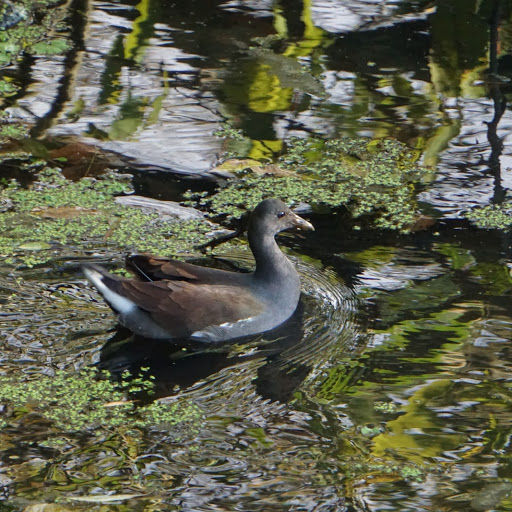
The Common Gallinule is not very common in Monmouth County. An immature Common Gallinule (picture by park patron Melody Ragle) is currently visiting Marlu Lake in Thompson Park and has been there for the last week or so. The adult is a blackish, chicken-like marsh bird, found near cattails and never far from water. It can often be seen swimming, picking at the water's surface, or walking along the edge of aquatic vegetation. The Common Gallinule has thick legs and long toes that are drab yellow. Adults have bright red bills with a yellow tip, thin white side stripes, and some white under the tail. Immature birds are paler and grayer than the adults and lack the brightly colored bill. The summer range for these birds extends north to the Canadian border, just west of the Mississippi, and south to the Gulf of Mexico. They winter along the East Coast and down through and across the Gulf states, over to Mexico and along the coast of California. (posted 10/29/19)
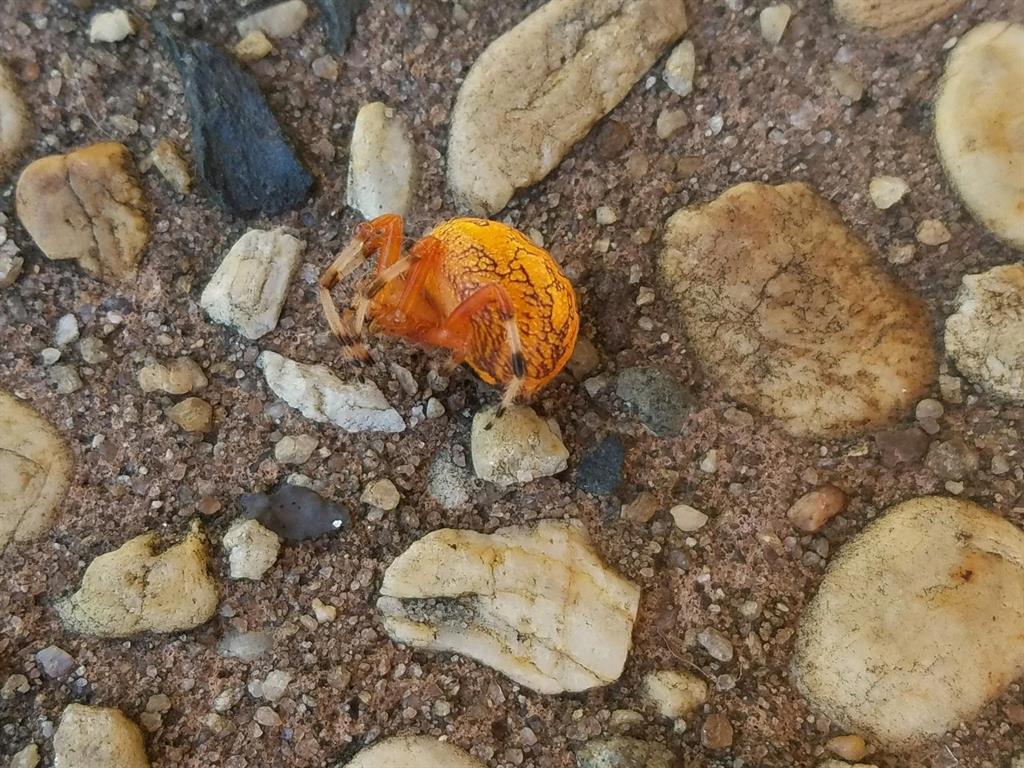

Along with pumpkins and leaves, brightly orange Marbled Orb Weavers are very popular during the autumn months in eastern United States. This arachnid can quickly be recognized by its unique marbled abdomen, orange head, and black and white banded lower legs. Like all other orb weavers, this spider creates a new circular web every day, preferring to build on shrubs or tall grasses near wooded areas. Females can easily be identified from males as they are 2-3 times larger. Although individuals can grow to be quite large, the species is unlikely a threat to humans. (posted 10/25/2019)
Baby Snapping Turtles

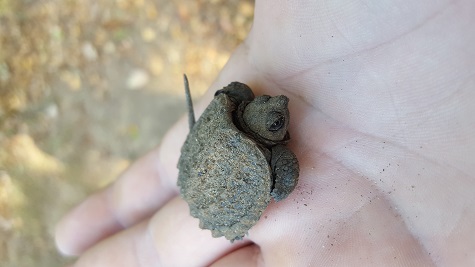
Large adult female common snapping turtles, Chelydra serpentine, come on land in the late spring to early summer to lay their nests. It isn’t until the fall that the eggs hatch and baby turtles come to the surface. Nests usually hatch three to six months after the mother turtle lays her eggs, depending on the weather, usually before November. Interestingly, the temperature of the nest determines the sex of the baby turtles. Colder temperatures produce males and warmer temperatures produce females. Once the babies hatch from the egg, the real danger starts as they have various predators such as birds and other wildlife. Our Park System Naturalist staff at the Manasquan Reservoir Environmental Center helped half a dozen of these little beauties find their way down to the water. Once they reach adulthood, they have very few predators but at this tender age can use all the help they can get. (posted 10/7/2019)
Late Bloomers
Summer’s peak bloom may be behind us, but that does not mean the flowers are done showing off! Here are two different MVPs, or Most Valuable Plants, side by side. On the left is White Snakeroot, and on the right is Late Boneset. Both flower during this time of year, and both can be found in meadows as well as abandoned lots and such. These particular individuals were photographed along the Huber Woods Discovery Path. White Snakeroot and Late Boneset are extremely valuable plants, attracting a wide swath of pollinators - bees, butterflies, beetles, flies, wasps, you name it! Below you can see some of the aforementioned visitors.

Painted Lady
Skipper
Buckeye
Painted Lady Butterfly on Sedum
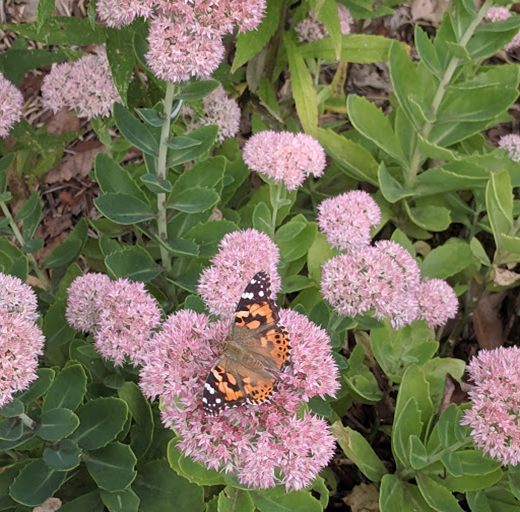
As a good late summer bloomer providing nectar when flowers are getting scarce, this sedum in the pollinator gardens at the Manasquan Reservoir Environmental Center has attracted several painted lady butterflies.
One of the most widespread butterflies in the world, the painted lady originates in northern Mexico and can be found throughout the northeast. Reasons for its success include the wide range of host plants the caterpillars can eat (including thistles, mallows, sunflowers and legumes) and their ability to migrate. Spring migration is sporadic but when the rains are abundant and population numbers are high enough, we’ll see a large irruption of these butterflies in the northern regions of the United States and Canada. In the fall, painted ladies migrate south to escape the cold. (posted 9/19/2019)

Also known as Funnel Web Spiders, Ground Spiders, Sheet Web Spiders or Funnel Weavers, these North American spiders are harmless. They can be identified by the arrangement of their eight eyes into three rows. The top row has two eyes, the middle row has four eyes, and the bottom row has two eyes (spaced wider than the ones on the top row). They have two prominent hind spinnerets, somewhat indistinct bands on their legs, and two dark bands running down either side of the cephalothorax. Their unique web is sheet like with a funnel that leads downward into a shelter, often vegetation or a rock crevice. (posted 8/27/2019)




Black Skimmers are a State endangered species of beach nesting bird that can be found each summer in Monmouth County when they come to breed along our shores. They are a magnificent looking long winged bird with sharp black and white color contrast of the body, black above and white below. Its name is derived from the distinctive black and red bill that it uses to skim the water for fish. The lower bill is shorter than the upper, and is used to feed by flying low to the water, lowering its lower bill to slice through the water, skimming the water for fish. When the bill touches a fish, the upper bill will snap down on its prey. It is a special treat to see one skimmer or even a flock of skimmers feeding along our waterways during the summer months. (posted 6/25/2019)
What’s Blooming in the Pollinator Garden?
With the official start of summer, spring flowers make way for the next palette of colors! These plants all began to bloom this month, and provide no shortage of color or form. Try to find them all on the Huber Woods Discovery Path.
Our Giant Hyssops began blooming this week. Their flowers are a soft purple. Over time, the plants will produce tall flower stalks with oppositely placed flowers. Move in for a sniff and smell something akin to anise or licorice. If you enjoy the smell you’re not alone - so do bees, hummingbirds, and butterflies.
This tall member of the aster family reaches well over four feet in height. The yellow flowers attract all sorts of pollinators too. Though it’s not a true genetic member of the sunflower genus, it has a close enough resemblance to earn the common name False Sunflower.
Here are four words you probably never would have strung together, Foxglove Beardtongue. This showy white flower is a North American native, and a favorite of bees and hummingbirds. Its Latin name is Penstemon digitalis, “digitalis” because its flowers look like fingers, and “penstemon” due to it containing five stamens per flower. It gets the name beardtongue due to one of its stamens containing a tuft of hair like fibers.
This cultivated hybrid of Thread Leaf Coreopsis is called Moonbeam, for its creamy soft yellow coloration. The common name is Tickseed, as its seeds tend to resemble…well, ticks! Throughout the summer, this plant will produce copious amounts of small flowers that are visited by all sorts of tiny pollinators. Coreopsis never get too tall, making them wonderful foreground and border plants.
These large white flowers belong to the Yucca - an evergreen plant. Its tall stalks get pollinated by none other than yucca moths. These small insects in the Prodoxidae family use yucca plants as hosts during egg-laying season. It is no coincidence that yucca flowers are white and also get pollinated by moths. Moths have an extremely well-developed sense of smell, therefore their host plants need not have vibrant colors.
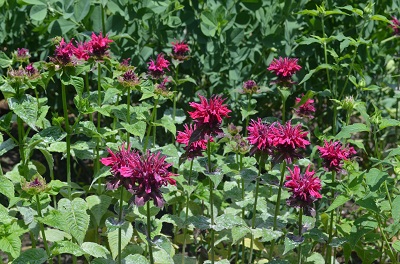
Bee Balm is a very common flower in native plant gardens, and for good reason. This plant produces large, beautifully vibrant flowers in summer. Give the leaves a rub and you’ll smell a minty scent. Though it’s called Bee Balm, this plant isn’t exclusive and will attract other pollinators like butterflies and hummingbirds. The aromatic leaves of this plant have traditionally been used in teas and salads. (posted 6/25/2019)
Grasshopper Sparrow (Ammodramus savannarum)
Dorbrook Recreation Area

The “proof is in the pudding” is a phrase that is often used to describe an idea put into practice that results in the desired outcome. The Park System's Acquisitions and Design department has a planning section that develops a plan for each and every field within every one of our county parks. These management plans can be disrupted from time to time due to weather, equipment availability, personnel availability, or the reordering of priorities. All of this can make it difficult to adhere to the specific plan. However, a particular management plan is working pretty well for a field at Dorbrook Recreation Area, Colts Neck.
The “proof in this pudding” is the presence of a state “threatened” grassland bird species, the Grasshopper Sparrow (Ammodramus savannarum). This secretive songbird requires open grassland for breeding. The open grassland habitat in New Jersey is dwindling due to development. To maintain open grasslands, a strict mowing regiment is required so that the right habitat can be created to coincide with the Grasshopper Sparrow’s (and other grassland species) breeding schedules. Grasshopper Sparrows have been returning to this same field at Dorbrook for several years now and have been breeding here since at least 2017, earning our planning department a “hats off” for a job well done.
Interestingly, Grasshopper Sparrows are more often heard than seen, as they prefer to stay down low in the grasslands. Their name is derived from their song that sounds similar to the buzz of a grasshopper. The photo posted above was taken just after a rain and this individual was perched on top of a common milkweed plant singing. It was just one of several Grasshopper Sparrows seen in that field that afternoon.
(posted 6/11/19)
Pollinator Garden Is Open For Business!

With the recent combination of heavy rains and intense sun, our Discovery Path Pollinator Garden at Huber Woods Park has come alive. Some plants were installed last year, while newcomers were planted this spring. Designed with a focus on native species, with a couple exceptions, over twenty species of pollinator plants are on display. Following this holiday weekend, our first set of plants has already bloomed. This week’s bloomers are Blue False Indigo Baptisia australis and Moonshine Yarrow Achillea moonshine.

Blue False Indigo

Moonshine Yarrow
Bonus photo! Eagle eyes can spot a baby monarch caterpillar, just hatched and feeding on a young milkweed plant.

Baby Monarch Caterpillar(posted 5/28/2019)
Red Fox at the Dorbrook Recreation Area


This adult fox and its kit were seen in a field on the south side of Route 537 in Dorbrook Recreation Area, Colts Neck. There are two species of fox that can be found in New Jersey - the red fox and the gray fox. The gray fox is more secretive and is not seen as often as the red fox. While the two species appear very similar in coloring, the red fox has a white tipped tail.
A member of the Canine (dog) family, the fox feeds primarily on small mammals with meadow voles making up about half of its diet. However, they also eat berries, fruit, insects, birds, amphibians and reptiles. They are efficient scavengers and appreciate open garbage containers. Foxes can weigh between 8 and 25 pounds. The life span of a red fox in the wild is only 18 months to 6 years. They usually will have between two to six kits in a litter but a litter of 13 was once recorded. These fur bearers readily adapt to human presence and will eagerly accept handouts. While not a physical or active threat to humans, foxes (like all wild animals) should be given a wide berth. This is especially true if the animal is acting strangely or appears ill, as the fox is a known rabies vector. (posted 5/21/19)
Eastern Box Turtle
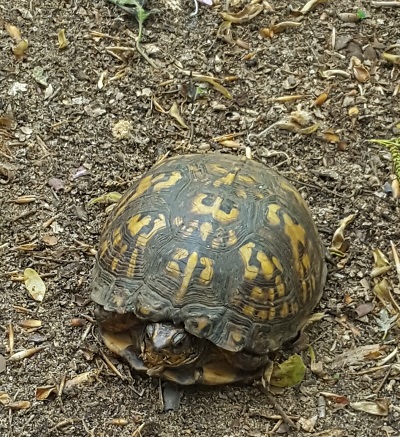
“Watch your step!” I heard while walking during last Saturday’s Roving Naturalist. This lovely Eastern Box Turtle was resting herself on one of the trails of Big Brook Park. True to its name, this turtle species has the ability to draw in its head and legs, then close its shell in the front like a box! This individual turned out to be a female box turtle, with its brown eyes. The males typically have red-colored eyes.
Usually found in forest habitats, box turtles eat a varied diet consisting of both plants and animals, including berries, mushrooms and insects. They have a homing instinct which will bring them back to their home territory after foraging for food.
Eastern Box Turtles are officially listed as a vulnerable species, as their population has been in decline. One of the main causes is due to pet trade collection. Please remember if you encounter one in the wild, leave it be and admire it without moving it. Thank you! (posted 5/7/2019)
American White Pelican
Henry Hudson Trail (North) - Natco Lake, Union Beach

An American White Pelican paid a rare visit to Monmouth County on April 30. The bird was seen on Natco Lake and was visible from the Henry Hudson Trail. These huge soaring birds can stand 5 feet tall, have a wing span of 9 feet and can weigh as much as 30 pounds; although, the mean weight is closer to 15 pounds. Life span in the wild is 16 years and one bird lived for 34 years in captivity. The American White Pelican is usually found west of the Mississippi River, north to Alberta and Saskatchewan, Canada, and south to Mexico. Recently, a population has been breeding in southwest Ontario.
These birds are uncommon but seen almost annually in New Jersey now. It is still rare for Monmouth County. Pelicans feed mostly on fish and will work in a group to manipulate schools of fish toward each other for easier fishing. The large fleshy protuberance or horn on its beak is grown during breeding season and drops off afterward. Both males and females have these horns. White pelicans usually have 2 to 3 chicks each year. The dark bird that photo bombed the pelican photo is a Double-crested Cormorant. (posted 5/01/19)
Reptile Sightings at the Manasquan Reservoir
Now that spring has arrived, we’re starting to see reptiles come out. We’ll often catch these cold-blooded creatures basking in the sun to warm up. So far we’ve had two notable sightings at the Manasquan Reservoir Environmental Center. Our first was a baby Painted Turtle (Chrysemys picta), who must have just emerged from its mother’s nest as it was only about the size of a nickel.

Baby Painted Turtle
Our second was a Northern Ringneck Snake (Diadophis punctatus edwardsii). These harmless small woodland snakes mostly eat earthworms and small salamanders. They can be differentiated from the Southern Ringneck Snake (Diadophis punctatus punctatus) by the yellow ring around its neck. The Northern Ringneck Snake’s ring goes completely around its neck while the Southern Ringneck Snake’s ring doesn’t.

Northern Ringneck Snake
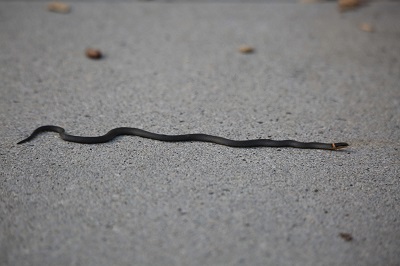
Northern Ringneck Snake
We were lucky enough to get some photos of these early sightings. If you get any great wildlife photos of your own at the Manasquan Reservoir or Deep Cut Gardens, consider entering our photography contests.
Here are the details:
Manasquan Reservoir Environmental Center’s Photography Contest and Exhibition
Join Manasquan Reservoir’s Photography Contest and Exhibition. This year’s theme - The Colors of Nature at the Manasquan Reservoir - highlights the ever-changing colors of nature and wildlife. Divisions include youth, adult amateur and professional. Categories are wildlife photography and general photography. Interested in entering? Submission time frames for each seasonal category are as follows:
- Spring - March 16 to May 30, 2019
- Summer - June 1 to August 30, 2019
- Fall - September 1 to November 30, 2019
Rules and entry form are available on the Manasquan Reservoir webpage. Your photographs will help us highlight the colors of the seasonal changes at the Manasquan Reservoir for winter visitors during the exhibition throughout the month of February.
Deep Cut Garden's Eight Annual Photography Contest and Exhibition
Every year the Deep Cut Garden's Photography Contest and Exhibition grows! This year’s theme - The Seasons of Deep Cut Gardens – highlights the ever-changing nature of this community treasure. Divisions include youth, adult amateur and professional. Interested in entering? Submission time frames for each seasonal category are as follows:
- Spring - March 16 to May 30, 2019
- Summer - June 1 to August 30, 2019
- Fall - September 1 to November 30, 2019
Rules and entry form are available on the Deep Cut Gardens webpage. Your photographs help us bring Deep Cut to life for winter visitors during the exhibition throughout the month of January.
(posted 4/30/2019)
Our Recent Spring Birding Expedition Trip

Wimbrels

Greater Yellowlegs
What a day! Birders on our recent Spring Birding Expedition were very lucky to see over 80 species of birds during their trip to the Edwin B. Forsythe National Wildlife Refuge and Great Bay Boulevard Wildlife Management Area. Sightings included a large numbers of Wimbrels (Numenius phaeopus) and close up views of the Greater Yellowlegs (Tringa melanoleuca).
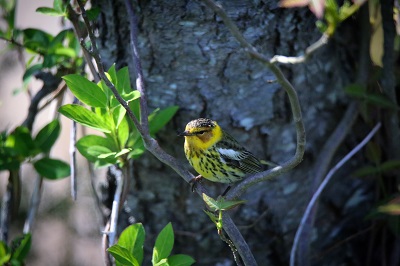
Cape May Warbler
The highlight of the day was getting a close up look at the Cape May Warbler (Setophaga tirgrina). This bird gets its common name from Cape May, New Jersey, where Alexander Wilson first described it. Unique among warblers for its curled and semi-tubular tongue that is used to collect nectar during winter; the Cape May Warbler breeds across the boreal forest of Canada and the northern United States. Its populations are largely tied to the availability of spruce budworms - its preferred food. These warblers are a spring and fall migrant in New Jersey.
Moths at the Manasquan Reservoir

The Figure Eight Sallow (Psaphida resumens) was one of the first moths caught at the Manasquan Reservoir Environmental Center this April. They are known to be one of the earliest moths found each spring and are quite cold resistant. So even though it’s too cold for most moths this early in the season, these little moths are already out nightly flying.
Wood Duck (Aix sponsa) in Hartshorne Woods Park



Arguably the prettiest duck in North America, the male Wood Duck has a chestnut brown breast, green crested head, bright red eyes, and bold white outlines. Females are warm brown with a white tear-drop eye ring. This duck truly looks like a hand-painted work of art. Although some will move a little south for the winter, Wood Ducks can be found year round in New Jersey. The population of these cavity nesting birds was in steep decline in the late 19th century due to overharvesting for their meat, the high demand for their feathers used in ladies hats, and loss of habitat - large trees with cavities.
The Migratory Bird Act of 1918 enabled the population to start a slow recovery and the population is on the rise in North America. Limits on harvest numbers, the development of nesting boxes, and the preservation of large tracts of land by conservation and government organizations further aided in the resurgence of the species. Wood Ducks readily accept nesting boxes and will often produce two clutches of 6 to 16 eggs per year. Their strong toenails aid in holding on to tree limbs and they will nest as high up as 60 ft. in a tree and as far as a mile away from water. The Wood Duck prefers small, woodland ponds and marshes, and is not often found in open water on large impoundments. They eat seeds, fruit, insects and other arthropods. Most are timid and will flush when approached too closely, as they are still highly prized by sportsmen. These beautiful birds can be found in virtually any of our parks with wetlands or a small pond. (posted 4/01/2019)
Is That a Sunflower Seed…In a Tree?


Photo taken at Tatum Park.
It can take a set of eagle eyes to notice this tiny insect. Surviving the bitter winter months by nestling itself into tree bark, believe it or not, this is a firefly. However, unlike its bioluminescent cousins, this species does not glow. The Winter Firefly, Ellychnia corrusca, is one of the few species of firefly to overwinter as an adult. As spring warms up, keep an eye out for these beetles feeding off of tree sap. Once the adults mate in spring, they soon expire making way for the next generation. (posted 3/27/2019)
Harp Seal at Bayshore Waterfront Park

Recently, a juvenile harp seal was seen swimming and resting on a beach at the Bayshore Waterfront Park, Port Monmouth. While harp seals spend most of their time diving and swimming in the icy waters of the North Atlantic and Arctic Oceans, they are also highly migratory. Following the breeding season, harp seals from the western North Atlantic will migrate south along the Labrador coast and sometimes as far south as the Jersey Shore feeding along the way on a variety of fish and crustaceans. They can stay underwater for 15 minutes. If you see a seal resting on a beach, please keep your distance and give the animal plenty of room - at least 150 feet. Approaching a wild animal can be considered harassment under the federal Marine Mammal Protection Act of 1972. (posted 3/20/2019)
Pileated Woodpecker
Huber Woods Park

This is a good time of the year to see a Pileated Woodpecker. There are few leaves to offer cover so it easier to locate them when they are knocking on a tree in search of food. The Pileated Woodpecker is the largest woodpecker in North America. That is unless you are one of the die-hard believers that think the Ivory-billed Woodpecker is still alive and well and hiding out in the backwoods of Arkansas, Louisiana, Florida or Texas. The Pileated is about the size of a crow, 16 to 19 inches long, weighs 8.8 to 12.3 oz., and has a wing span of 26 to 30 inches. They prefer mature forests.
Ten years ago it was difficult to find this beautiful woodpecker in Monmouth County. Now, virtually all of our county parks boast a pair of these large insectivores. Pileated Woodpeckers have recently been seen in Holmdel Park, Tatum Park, Huber Woods Park, Hartshorne Woods Park, Thompson Park, Clayton Park, Perrineville Lake Park, Dorbrook Recreation Area, Shark River Park, Turkey Swamp Park, Big Brook Park and Freneau Woods Park. These birds will hammer out a large rectangular excavation in search of their favorite food, carpenter ants. Pileated pairs stay together year round and will defend their territory for most of the year. The oldest known Pileated Woodpecker was 12 years and 5 months. It was a banded bird that had been recaptured and then released. It is believed that these birds have a life span of about 13 years. This male Pileated, pictured above, and its mate can often be seen at Huber Woods Park. (posted 2/21/2019)
Manasquan Reservoir Bald Eagles Incubation Begins!

Photo by Aubrey Merrill
On February 11, our resident bald eagle pair began incubation. From now on, one of the adults will almost always be on the nest. Eagles begin sitting immediately upon producing their first egg and may lay an additional two more eggs over the following days. Hatching generally begins occurs 35-40 days after. We are anticipating hatching approximately the third week of March. Nesting Bald Eagles are very sensitive to disturbance by humans and could easily abandon their nest. The nest can be safely viewed from the walking path adjacent to Georgia Tavern Road or by TV monitor inside the Manasquan Reservoir Environmental Center, Howell. (posted 2/13/2019)
Harbor Seal

Recently, a harbor seal (Phoca vitulina) was seen resting near the beach at Seven Presidents Oceanfront Park in Long Branch, NJ. This harbor seal was most likely part of the Western Atlantic Harbor Seal population, which ranges from eastern Canada to New Jersey, with reports of individual seals being spotted as far south as Florida. Most species of seals need quiet and safe places to rest in order to digest their fishy meals and relax after a long swim foraging for food, such as herring, menhaden, or flatfish. Like all marine mammals, seals are protected under the MMPA (The United States Marine Mammal Protection Act of 1972), so if you spot a seal resting on rocks or on a beach, please give it some space and view this fascinating creature from afar. (posted 2/5/2019)
Cooper’s Hawk
I find hawks tricky to tell apart. Many times you are either looking up at the underside of a bird overhead, or, like this one, within the branches of tree. And, when consulting my bird guide, I can’t always see the ‘defining’ trait! I often ask the bird to spin around so I can see if he has a wing bar or a rusty-reddish crest that I can’t see, but they never comply! I always take my camera with me when I go birding. I’m not expecting to get an amazing shot. I just find it easier to look at the bird right then, by magnifying it on my camera, or later on my computer. If I need help identifying it, having a photo helps.
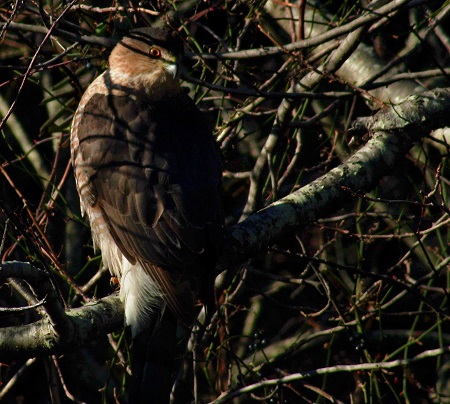
This is a Cooper’s Hawk that I saw on Sunday. It is a medium-sized raptor often seen flying within the dense canopy of trees in wooded areas. Cooper’s Hawks prey on other birds and are excellent flyers. They are swift and nimble and are able to catch a bird, such as a robin or blue jay, in flight. While they form faithful pairs for a season or two, most do not mate for life. The males are much smaller than the females although both are similar in coloration. Cooper’s Hawks can live for between 12 and 20 years. Their main threat is habitat loss.

I was having trouble identifying this bird and thought I would share the tip that my ‘birding mentor’ gave me. When trying to tell the difference between a Cooper’s Hawk and a Sharp-shinned hawk perched in a tree, draw an imaginary line from the top of its beak toward the back of its head. If its eyes are below the line, it is a Cooper’s Hawk. Luckily, this fellow showed me his profile!

Happy Birding! (posted 1/24/2019)
Northern Saw-whet Owl
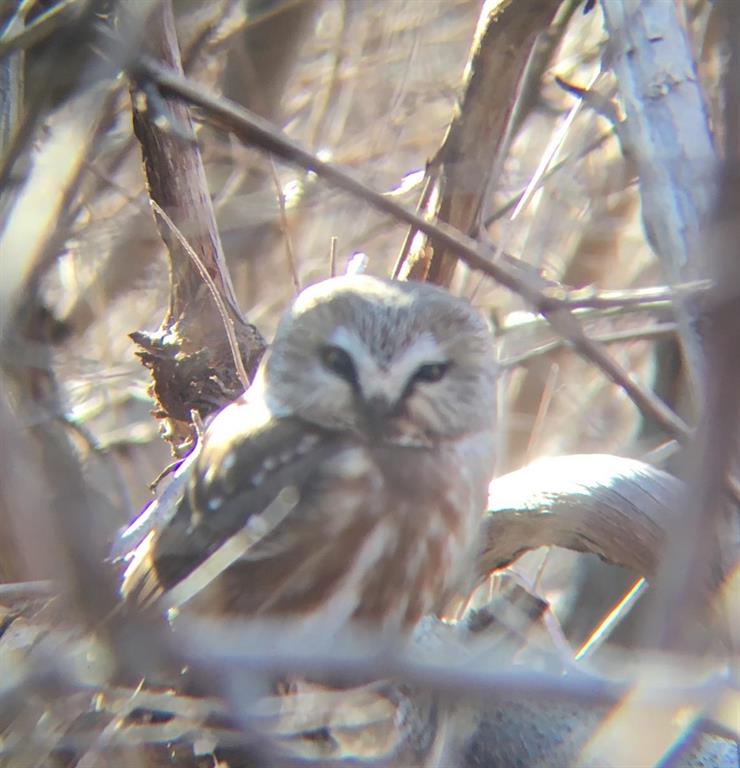
Winter brings many birds southward where temperatures are more moderate and food is a bit easier to find. The Northern Saw-whet Owl is one such winter visitor to our parks. These birds are among the smallest raptors in North America. They are about 7 to 8 inches long, weigh between 3.3 and 5.3 ounces, and have a wingspan of 16.5 to 18.9 inches. Saw-whets breed in the northern half of North American with some areas extending on the east coast into New York and into the northern half of Pennsylvania, out west the breeding range extends down into the Rockies as far south as New Mexico and Arizona, and along the west coast into the middle of California. These owls are monogamous for the season and will have a brood of four to six chicks. They are cavity nesters, often using cavities abandoned by northern flickers and hairy woodpeckers. Northern Saw-whets only live for about two to four years in the wild, with the longest known wild bird having lived seven years. Captive birds have lived as long as seventeen years. The owl is named for its call which can sound like a saw blade being sharpened on a whetstone (I am sure everyone knows that sound). Northern Saw-whets start arriving in New Jersey as early as October and some may stay until mid April.

Saw-whets are nocturnal hunters, preying on small mammals and small birds. They generally hunt at night from a low perch along the forest's edge. These are very common owls but are not that easy to find. Their mottle brown coloring and white face tend to make them almost invisible in the winter thickets. Saw-whets spend the day hidden in conifers like cedars and spruce or under honey suckle vines, usually between two and ten feet off the ground. They will very rarely flush from their roost as songbirds in the area will mob them if discovered. These owls are preyed upon by larger birds of prey such as Great Horned Owls, Screech Owls, Cooper’s Hawks and Peregrine Falcons. This individual was spotted by a Park System ranger who has developed a real knack for locating these hard to find beauties. Photos by Alison Astalos and Patrick Becker. (posted 1/23/2019)
Ootheca


Often mistaken for mold or a mushroom, this peculiar structure was created by an insect, a Praying Mantis. It is known as an ootheca. Greek in origin, ootheca translates to mean “egg cover”. The name is very appropriate as inside this egg case, overwintering through the cold are hundreds of mantis eggs. They will hatch out of the ootheca during the warmer months, disperse and begin the life cycle anew. This specimen was found in Big Brook Park, Marlboro. (posted 1/2/2019)
Back to Nature Now